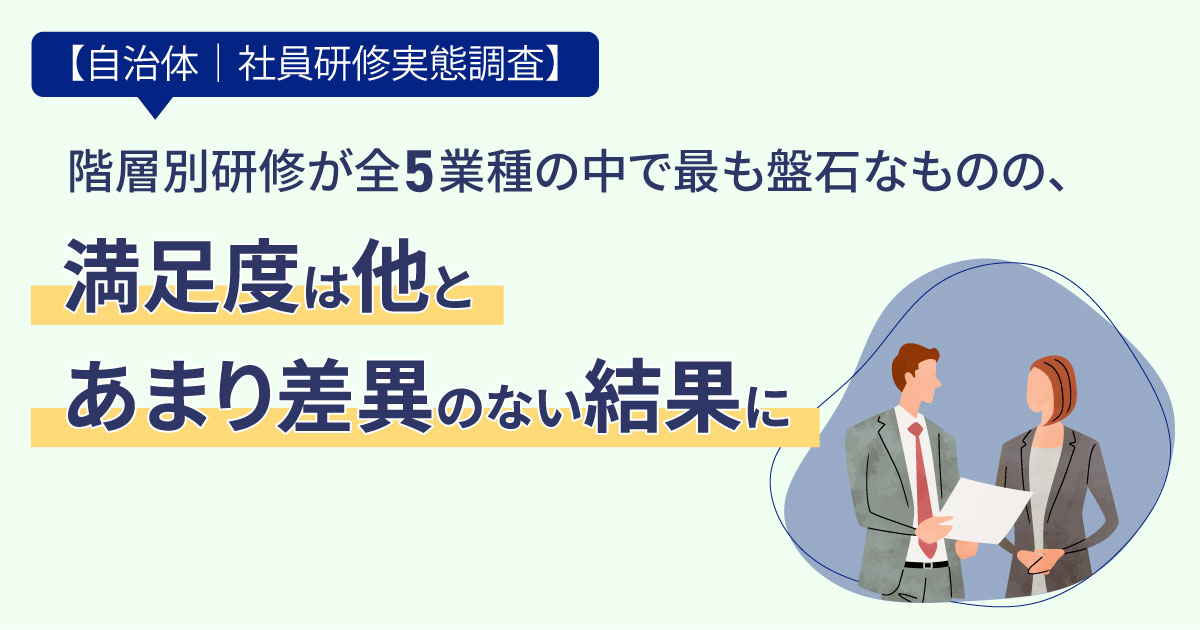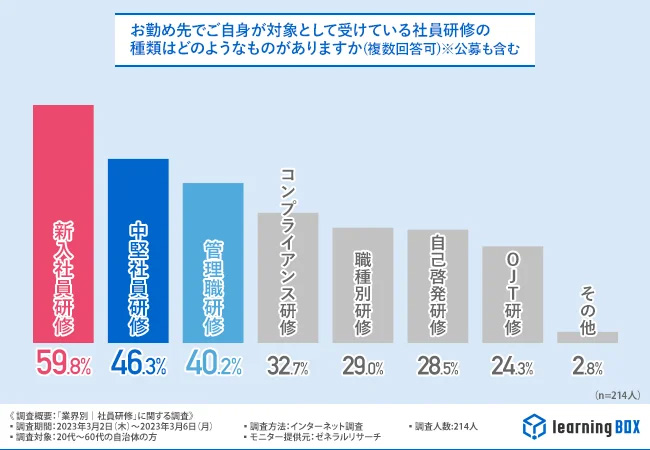
LearningBOX, Inc. conducted a survey on "Employee Training by Industry" among local government officials in their 20s to 60s.
Of the results of the survey, which covered a total of five industries*, we are pleased to announce the results for municipalities.
*5 industries in total: medical care, finance, retail, manufacturing, and local government.
Survey Results Topics
The results show that the training system by rank is the most robust among all five industries.
0Satisfaction with training was the highest among all five industries at 62.7
<Survey Summary
1. survey method: web-based questionnaire using monitors from General Research Corporation
2. survey target: Municipalities in their 20s to 60s among the registered monitors of General Research
3. number of valid responses: 214
4. survey dates: March 2, 2023 (Thursday) to March 6, 2023 (Monday)
<Results of the survey of other industries
Medical Care:https://learningbox.co.jp/news/medical_care_report/
Finance :https://learningbox.co.jp/news/finance_report/
Retail :https://learningbox.co.jp/news/retail_report/
Manufacturing :https://learningbox.co.jp/news/manufacturing_report/
The results show the most robust training system by rank among all five industries.
A survey of 214 municipalities was conducted.
First, when asked in what format they conduct employee training (staff), the results were "online (11.7%)," "face-to-face (46.7%)," and "both online and face-to-face (41.6%).

Next, what types of employee training do you yourself receive at your company? (When asked (multiple answers allowed, *including open recruitment), the most common response was "New employee training (59.8%)," followed by "Mid-level employee training (46.3%)" and "Management training (40.2%).
Compared to other industries, the results show that training is well implemented by rank.
The percentage of responses for other types of training was also high, and it appears that overall, the training is more generous than in other industries in terms of training.
Satisfaction with training was the highest among all five industries at 62.7
When asked about their level of satisfaction with their current training, approximately 60% (62.7%) were satisfied, the highest among all five industries.
About 70% (73.3%) of the respondents answered that the content of the training is being applied to their work, while about 80% (80.9%) thought that the content of the training needs to be changed every year.
The following responses were found regarding satisfaction with the current training program.
・The required training changes according to the career path, so it is efficient to avoid wasting time (20s / Tokyo).
I was able to learn knowledge that I myself lacked, and I was able to apply it to my work (30s / Aichi Prefecture)
The national overnight training program for each department allowed me to form a network of contacts (50s/Shiga Prefecture).
I was able to use the knowledge I gained from the management training to educate my subordinates (50s / Yamagata, Japan).
They seem very satisfied with the availability of the necessary training when they need it, but the content itself may need to be changed.
Despite high satisfaction with training, challenges faced are not very different from those in other industries
When asked, "What are the challenges you face in training? (multiple answers allowed), the most common response was "After a while, (employees) forget the content of education and training (37.9%)," followed by "Cannot acquire sufficient knowledge and skills (31.8)" and "No place to put acquired knowledge and skills to use (25.2%).
Specifically.
The content of the training may not be used on a daily basis (20s / Gifu Prefecture).
Even if I think it is important when I learn something, I don't have a chance to make use of it, and sometimes I forget what it was when I feel it is necessary (30s / Aichi Prefecture).
Many of the training sessions have the same contents every year (40s / Mie)
It is good to have training sessions that bring together people from various workplaces, but it is difficult to provide training that satisfies everyone because the needs of the participants vary (60s / Hyogo Prefecture).
The respondents seemed to feel that they were facing challenges such as the following.
Even though they are the most satisfied of all the five industries, there does not seem to be much difference in terms of the challenges they face.
What do you think should be important for training in the municipal field?
When asked what they consider important in terms of training, the most common responses were "Designing education and training that matches the staff (employee) level (53.3%)" and "Implementing training that can be applied in the field (53.3%)," followed by "A system and environment that allows repetition until the content takes root (44.4%).
I asked for more specifics,
I would like to see more training outside the company (30s / Iwate)
I think we also need time to "learn" properly. Frankly speaking, there are so many things to do that it is difficult to find time for them. Sometimes I have to cut down my break time to do it (30s / Aichi Prefecture).
I would like to have concrete examples and stories of failure to make it easier to understand (40s / Aichi).
The content of the training should match the current issues. Also, training that gives the feeling of being forced to do something is not good (60s / Nagano).
The responses included the following.
Summary: Local government training programs are generous and highly satisfactory, but there are challenges in changing the content.
The results show the highest level of satisfaction among all five industries, and indicate that they provide extensive training for each level of employees.
It is thought that the ability to learn what is necessary at the right time through training may have contributed to the level of satisfaction.
However, there was not much difference from other industries (medical care, finance, retail, and manufacturing) in terms of issues and important points to be considered, and the results show that the same changes and improvements in content are needed.
Although the results showed a high level of satisfaction with the training program, as evidenced by the generosity of the training program, it appears that the training program needs to be flexible and adjusted before it becomes a mere skeleton.